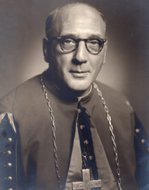THE AIM FOR THE ESTABLISHMENT OF THE INSTITUTE
As early as the 1960’s, the late Bishop Anthony Konings had a dream of founding a Religious Institute. Every generation faces new challenges and gives birth to people who can meet those challenges. It is God who raises such leaders and visionaries from among the people, who are enabled to respond to particular challenges of their time.
He announced his plans during the Easter Conference in the 1960s, to start an Institute of Indigenous Religious Women. However, the Institute took off in 1971. It is a Diocesan Institute of active Religious Women, tasked with a mission to respond to the call of Christ and spread the Good News of the Kingdom of God by our way of life.
When Bishop Anthony Konings was asked about his intention for the establishment of the Religious Institute, he had this to say:
“I had two main reasons for this founding. Firstly, that the ‘religious’ life is an integral part of the Church and there is a certain percentage of humanity, which wants to dedicate the necessary facilities for its implementation.
Secondly, that in 1970 when the Institute was started, it was already obvious that the missionary era was rapidly coming to a close and that the work which the missionaries were doing would very soon have to be taken over by the local people." In the Dioceses of Keta, the provision of Indigenous religious sisters looked promising and it was high time that steps were taken to make it possible for local Sisters to take over the work so far being done by missionaries from Europe. "To my mind, the need for the establishment of a Diocesan Society or Institution of Religious Women looked very urgent indeed.” (Adapted from Bishop Konings’ letter to Sister Patricia (OLA), 1st February, 1983).
Another letter written to Sister Patricia when they later asked about the ‘founder and His Spirit’, Bishop Konings stated;
“My aim of erecting this Diocesan Sisterhood was entirely pragmatic, - that is, to solve the problem of people in a practical and sensible way, rather than having fiscal ideas and theories. It was obvious that the missionary era was practically over; for the work of the European Sisters – Educational, Social and Medical not to die with them, a Institution of African Sisters was necessary to carry on that part of the Mission of the Church.”
 Bishop Anthony Konings started the Institute of the Sisters of Mary, Mother of the Church as an important aspect of the total structure and development of the Local Church. This was so because he saw so many Ewe girls join other Institutes in Ghana and Togo yet the Diocese of Keta had no local Institute.
Coupled with that, many girls in the Diocese also expressed the desire to join the religious life, and as already mentioned, since there was no female religious Institute in the Diocese, the girls were departing to other parts to fulfill this desire.
Bishop Konings therefore, inspired by the Holy Spirit, saw this as the right time to start a formation for the indigenous Sisters to keep them “home,” to continue the work of the missionaries in the Diocese. This was because he envisioned that, if He did not do anything to reverse the situation of the departure of the prospective candidates to the religious life from the Diocese, when all the missionaries are gone and the vacuum their departure will create.
Bishop Anthony Konings started the Institute of the Sisters of Mary, Mother of the Church as an important aspect of the total structure and development of the Local Church. This was so because he saw so many Ewe girls join other Institutes in Ghana and Togo yet the Diocese of Keta had no local Institute.
Coupled with that, many girls in the Diocese also expressed the desire to join the religious life, and as already mentioned, since there was no female religious Institute in the Diocese, the girls were departing to other parts to fulfill this desire.
Bishop Konings therefore, inspired by the Holy Spirit, saw this as the right time to start a formation for the indigenous Sisters to keep them “home,” to continue the work of the missionaries in the Diocese. This was because he envisioned that, if He did not do anything to reverse the situation of the departure of the prospective candidates to the religious life from the Diocese, when all the missionaries are gone and the vacuum their departure will create.